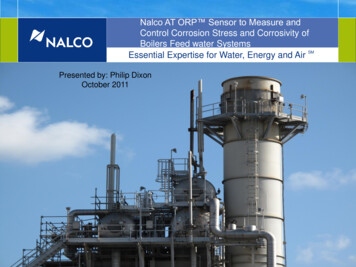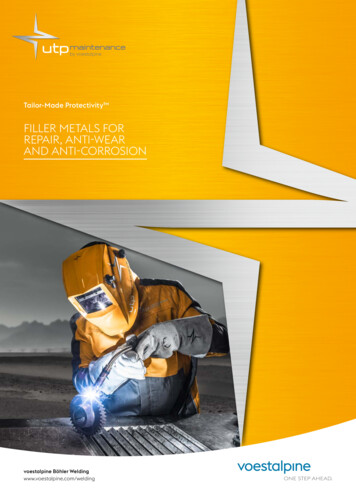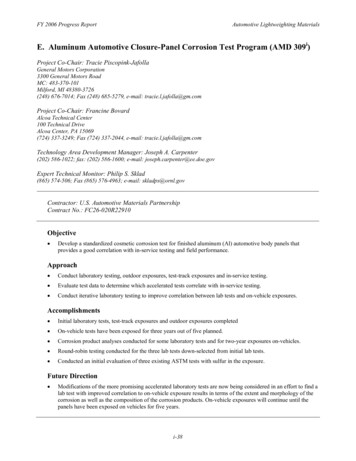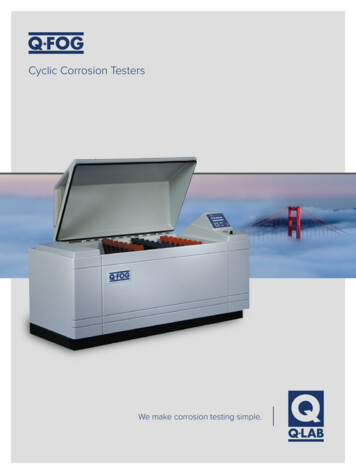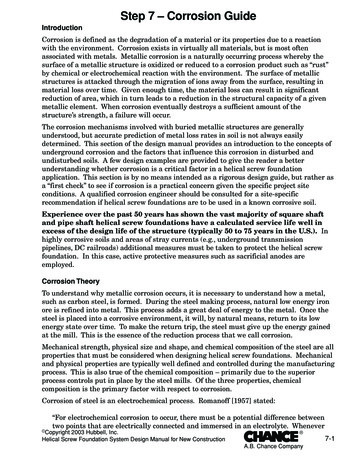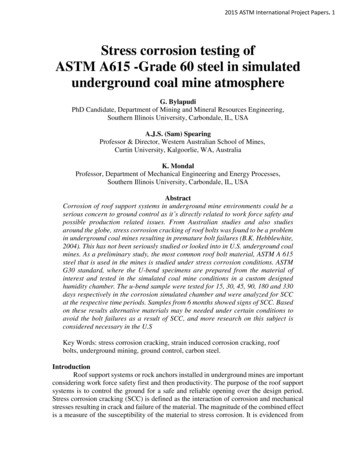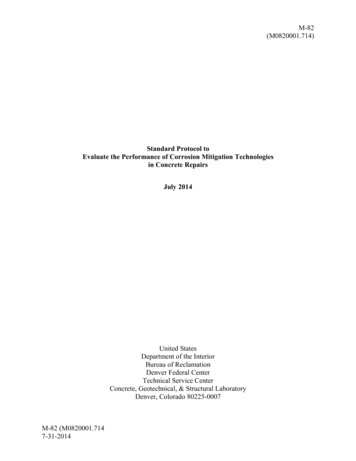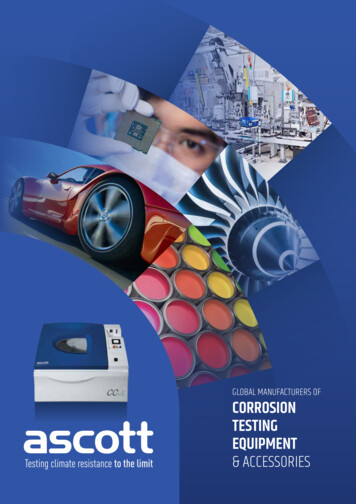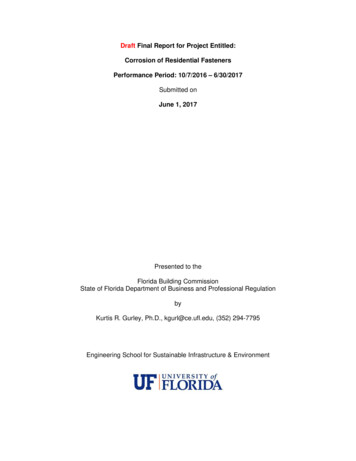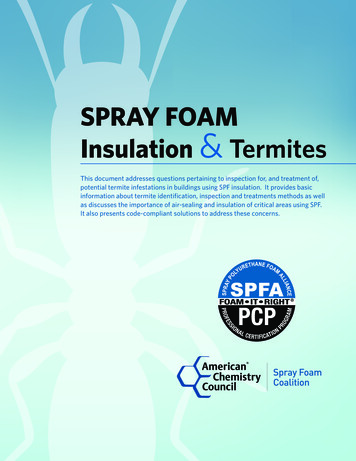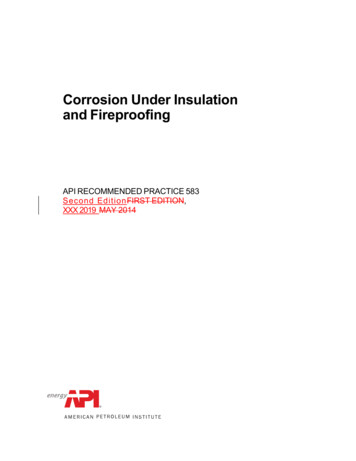
Transcription
Corrosion Under Insulationand FireproofingAPI RECOMMENDED PRACTICE 583Second EditionFIRST EDITION,XXX 2019 MAY 2014
Special Notes – will be updated by API editingAPI publications necessarily address problems of a general nature. With respect to particular circumstances, local,state, and federal laws and regulations should be reviewed.Neither API nor any of API's employees, subcontractors, consultants, committees, or other assignees make anywarranty or representation, either express or implied, with respect to the accuracy, completeness, or usefulness of theinformation contained herein, or assume any liability or responsibility for any use, or the results of such use, of anyinformation or process disclosed in this publication. Neither API nor any of API's employees, subcontractors,consultants, or other assignees represent that use of this publication would not infringe upon privately owned rights.API is not undertaking to meet the duties of employers, manufacturers, or suppliers to warn and properly train andequip their employees, and others exposed, concerning health and safety risks and precautions, nor undertaking theirobligations to comply with authorities having jurisdiction.Information concerning safety and health risks and proper precautions with respect to particular materials andconditions should be obtained from the employer, the manufacturer or supplier of that material, or the material safetydatasheet.Where applicable, authorities having jurisdiction should be consulted.Work sites and equipment operations may differ. Users are solely responsible for assessing their specific equipmentand premises in determining the appropriateness of applying the recommended practice (RP). At all times usersshould employ sound business, scientific, engineering, and judgment safety when using this RP.API publications may be used by anyone desiring to do so. Every effort has been made by the Institute to assure theaccuracy and reliability of the data contained in them; however, the Institute makes no representation, warranty, orguarantee in connection with this publication and hereby expressly disclaims any liability or responsibility for loss ordamage resulting from its use or for the violation of any authorities having jurisdiction with which this publication mayconflict.API publications are published to facilitate the broad availability of proven, sound engineering and operatingpractices. These publications are not intended to obviate the need for applying sound engineering judgmentregarding when and where these publications should be utilized. The formulation and publication of API publicationsis not intended in any way to inhibit anyone from using any other practices.Any manufacturer marking equipment or materials in conformance with the marking requirements of an API standardis solely responsible for complying with all the applicable requirements of that standard. API does not represent,warrant, or guarantee that such products do in fact conform to the applicable API standard.All rights reserved. No part of this work may be reproduced, translated, stored in a retrieval system, or transmitted by any means,electronic, mechanical, photocopying, recording, or otherwise, without prior written permission from the publisher. Contact thePublisher, API Publishing Services, 1220 L Street, NW, Washington, DC 20005.Copyright 2014 American Petroleum Institute
Foreword– will be updated by API editingNothing contained in any API publication is to be construed as granting any right, by implication or otherwise, for themanufacture, sale, or use of any method, apparatus, or product covered by letters patent. Neither should anythingcontained in the publication be construed as insuring anyone against liability for infringement of letters patent.Shall: As used in a standard, “shall” denotes a minimum requirement in order to conform to the specification.Should: As used in a standard, “should” denotes a recommendation or that which is advised but not required in orderto conform to the specification.This document was produced under API standardization procedures that ensure appropriate notification andparticipation in the developmental process and is designated as an API standard. Questions concerning theinterpretation of the content of this publication or comments and questions concerning the procedures under whichthis publication was developed should be directed in writing to the Director of Standards, American PetroleumInstitute, 1220 L Street, NW, Washington, DC 20005. Requests for permission to reproduce or translate all or any partof the material published herein should also be addressed to the director.Generally, API standards are reviewed and revised, reaffirmed, or withdrawn at least every five years. A one-timeextension of up to two years may be added to this review cycle. Status of the publication can be ascertained from theAPI Standards Department, telephone (202) 682-8000. A catalog of API publications and materials is publishedannually by API, 1220 L Street, NW, Washington, DC 20005.Suggested revisions are invited and should be submitted to the Standards Department, API, 1220 L Street, NW,Washington, DC 20005, standards@api.org.iii
ContentsPage1Scope. 12Normative References. 133.13.2Terms, Definitions, Acronyms, and Abbreviations . 2Terms and Definitions . 2Acronyms and Abbreviations . 744.14.24.34.44.5Introduction to the Causes of Damage . 7General . 7CUI in Carbon and Low Alloy Steels . 8CUI in Austenitic and Duplex Stainless Steels . 9CUF in Carbon and Low Alloy Steels. 11CUI on Aluminum Piping . 1155.15.25.35.45.55.65.7Areas Susceptible to Damage. 11General . 11General Areas of Damage. 12Pressure Vessels . 13Piping . 13Tankage and Spheres . 16Heat-traced Systems . 16Shutdown/Mothballing. 1766.16.26.36.46.577.17.27.3Insulation and Fireproofing Systems. 18Insulation Materials . 18Insulation Jacketing . 24Caulking . 26Fireproofing Materials . 27Coatings Under Insulation and Fireproofing Systems . 32Inspection for CUI and CUF Damage . 34General . 34Inspection of Piping Operating Below 32 F (0 C) . 35Inspection Tools and Methods . 3588.1Risk-Based Inspection (RBI) . 51General . 5199.19.29.39.49.59.69.79.89.99.10Design Practices to Minimize CUI . 52General . 52Coatings for Hot and Cold Services. 53Insulation Materials . 53Jacketing. 54General Design Aspects . 56Insulation . 59Heat-traced Systems . 60Protective Coatings and Caulk . 60Shutdown/Mothballing. 61Quality Control/Quality Assurance . 61v
ContentsPage1010.110.210.310.410.510.6Design Practices to Minimize CUF. 61General . 61Dense and Lightweight Concrete. 62Lightweight Cementitious Products . 62Intumescent Coatings and Subliming Compounds. 62Protective Coatings . 62Quality Control/Quality Assurance . 621111.111.211.311.411.511.611.711.8Maintenance and Mitigation of CUI/CUF Issues . 63General . 63Programmed/Condition-based Maintenance. 63Execution.
should employ sound business, scientific, engineeri ng, and judgment safety when using this RP. API publications may be used by anyone desiring to do so. Ev ery effort has been made by the Institute to assure the accuracy and reliability of the data contained in them; however, the Institute makes no representation, warranty, or guarantee in connection with this publication and hereby expressly .
